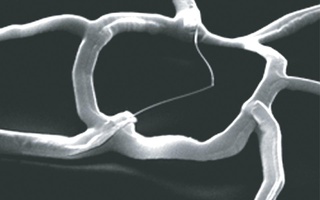Current top-down methods of chip production use electron beam lithography, an expensive process that involves etching silicon into smaller and smaller pieces. Such methods will eventually hit a limit at which further miniaturization would entail extreme expense.
"The current microelectronic industry will hit a wall in the near future," says Assistant Professor of Chemistry Hongkun Park.
Instead of taking large structures and cutting them into smaller pieces, however, some scientists, however, are taking the opposite approach. Using a bottom-up approach, they are focusing on taking extremely small units and combining them into working machines
In November, Science ran a special issue on the present reality and the possibilities of nanotechnology, the building of complex structures atom by atom. Possible applications include quantum cryptography, exotic new materials and, of course, miniature computers.
According to Lieber, using the bottom-up approach to make logical devices involves steps where the parts of a microchip are first fabricated and then arranged to form complex logical devices.
BF: Vacuum Tubes to Nanotubes
Making the basic units of a microchip in nanoscale is challenging in itself. The Lieber group has used nanowires made of silicon with added chemical impurities that allow the material to conduct some electricity.
Another top candidate for the building blocks of extremely small computers are carbon tubes two hundred nanometers across, called nanotubes.
Read more in News
Council Supports Online Concentration GuideRecommended Articles
-
Women's Lacrosse Drops to TerriersThe end of Spring Break hits all Harvard students hard. Yesterday, the women's lacrosse team had its rude awakening. After
-
Chemistry Professor Garners Prize for Nanotech InnovationHyman Professor of Chemistry Charles M. Lieber recently received this year’s World Technology Award for Materials for his work in
-
Team Develops Nanowire RingsHarvard researchers have developed a breakthrough nanowire technology integrated into high-tech electronic circuits—which, among other things, could help manufacturers significantly
-
Research Assists Cancer TestsHarvard researchers have found new ways of assembling nanowires—ultra-thin wires that have the potential to revolutionize electronics—and a new application
-
Chemistry Researchers Bend NanowiresA group of researchers in the lab of chemistry professor Charles M. Lieber have found a way to synthesize two- and three-dimensional versions of the microscopic strands known as nanowires—a breakthrough that researchers say may greatly increase the reach and applicability of the field by allowing scientists to design vastly more complex structures.
-
 ‘Cyborg Tissue’ Created
‘Cyborg Tissue’ Created













